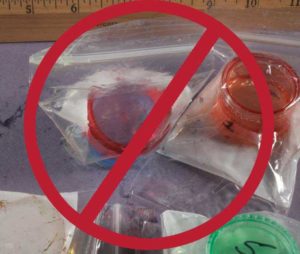Why Packaging Matters
Whether you are packing up samples for storage or to send out for analysis, packing your samples in the wrong materials can have unexpected consequences.
Sample Handling and Packaging
Summary
Proper sample packaging can mean the difference between a successful or a failed analysis. In techniques that analyze small areas or are used to determine trace chemical composition, packaging that appears innocuous can contribute as much material as was present initially.
Introduction

In any chemical analysis, the results are only as good as the sample itself. The sample will not represent the process or material examined if the sample integrity is not maintained. This is particularly true of the analysis work conducted by Analytical Answers, Inc. Our techniques are designed to examine small spots and detect low levels of materials. If contamination occurs from the packaging material, on a small sample this could skew the analytical results.
An example of this type of contamination that one of our scientists encountered brings to the front the serious issues represented here. The scientist was approached by an archaeologist who had discovered vessels that had contained liquids. Since the vessels were sealed there was some residual material present. The archaeologist was very excited about the find but since the actual vessels were in a very inaccessible place, the scientist was forced to transfer the precious liquid to plastic bottles.
He then brought the bottles to the scientist lab for analysis hoping to find remnants of an ancient wine making process. Instead the scientist found a material called dioctyl phthalate (DOP) in large amounts in every sample. Dioctyl phthalate is a material that was first used in the 1940s to soften stiff polymers and was unheard of prior to the very early 1900s.
What happened?
The plastic bottles that the researcher used were PVC (polyvinyl chloride). PVC is a very rigid polymer and is softened for other uses by the addition of DOP. When the precious samples were placed in the PVC jars, the sample extracted the DOP from the bottles and the DOP became enriched in the sample. When the sample was analyzed, the contents were overwhelmed by the DOP.
What should the researcher have done?
Packaging any sample for analysis requires that you minimize the amount of contamination that can get to the sample. Two common materials are appropriate: They are glass or aluminum foil. The best approach for the researcher would have been to put the samples into clean glass jars or bottles and to line the cover with aluminum foil. That would have prevented the extraction of the DOP from the bottle, and by lining the cap with aluminum foil, there would have been no potential extraction of materials from the lid liner.
What should I do?
In general aluminum foil (ordinary household type) is the preferred packaging materials for solids. Plastic bags and wraps are coated with processing aids and these are significant interferents for techniques such as Auger, ESCA and FTIR.
Foil also works well with static sensitive microelectronics. Conductive foams and plastics used for microelectronic packaging are again usually heavily treated and are a major source of interferents.
For liquids, the best containers are clean glass vials. If the vials are purchased from a laboratory glass ware supply house, a rinse with a clean solvent such as isopropanol and then air drying (upside down) is usually sufficient. Sending a sample of the solvent used to wash the vials is also a good idea. This is referred to in analytical chemistry parlance as a “Blank.” If laboratory glass vials are not available, household glass containers such as home canning jars (Mason jars) are a reasonable substitute. After washing with soap and hot water and thoroughly rinsing they can be used. In this case though, the covers should be lined with aluminum foil to prevent the sample from coming in contact with the rubber seal on the lid.
Markings
All samples received for analysis should be clearly marked with as much information as possible. The markings should reflect the identifications and terminology that you require for use in our images, spectra and reports.
Samples that require refrigeration, or are perishable should be marked clearly and shipped promptly, under appropriate cooled conditions. If the samples are visible or ultra-violet sensitive that should be clearly marked on the outside of the container so that they can be opened under appropriate subdued light conditions.
Biohazards
We have a very strict policy concerning potentially biohazardous materials. Samples of medical products and devices, even if unused, require either a statement of non-hazard or a certificate of sterilization.
Summary
We return all unused portions of samples following analysis, unless instructed in writing to do otherwise. Materials that require special packaging and labeling will incur additional costs. Check with your shipper to see if sending us the necessary return packaging and labels along with the samples is less costly.
